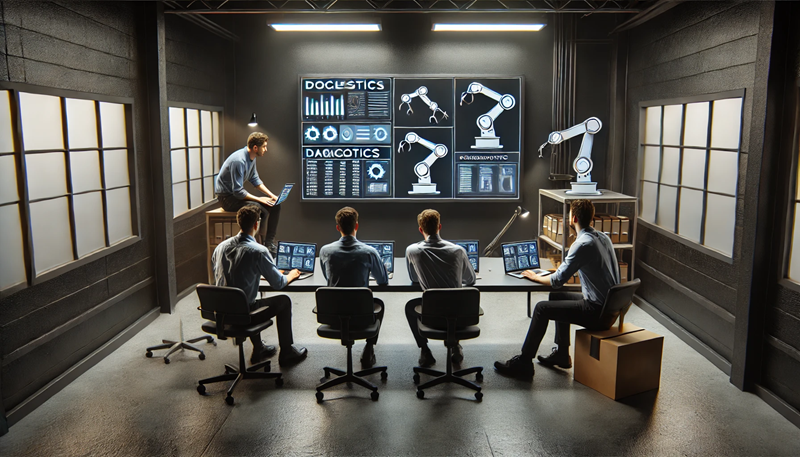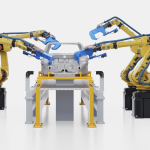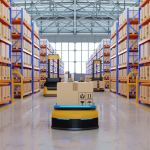The manufacturing sector is at a crossroads, driven by the convergence of labor shortages, rising costs, and the relentless demand for production efficiency. The industry has turned to digital twins—virtual replicas of physical environments—as a transformative tool to tackle these challenges. Digital twins allow manufacturers to simulate, test, and optimize operations in a virtual space, avoiding disruption to real-world workflows while minimizing costs and risks.
Now, NVIDIA’s Mega Omniverse Blueprint is taking this technology to a new level, redefining how automation, AI, and robotics are integrated into manufacturing facilities. For operations leaders, this framework isn’t just about digital twins—it’s about creating an entirely new operational paradigm.
From Digital Twins to Operational Transformation
The adoption of digital twins has surged, with nearly 75% of advanced industries implementing them, according to McKinsey. Their ability to simulate complex systems has proven invaluable in optimizing processes, reducing downtime, and enhancing safety. NVIDIA’s Mega builds on this foundation, introducing a framework that enables manufacturers to develop, test, and refine robotic systems at scale within a virtual environment before deploying them in real-world operations.
What makes Mega transformative is its ability to address the complexities of integrating advanced automation systems. By simulating real-world conditions, it provides manufacturers with a low-risk environment to experiment with automation strategies, optimize workflows, and refine robotic control systems. This isn’t just an operational enhancement—it’s a strategy for building more agile and resilient facilities.
Software-Defined Factories
The Mega Omniverse Blueprint introduces the concept of software-defined facilities, enabling continuous development, testing, and deployment. It integrates NVIDIA’s accelerated computing, AI capabilities, and Omniverse technologies into a cohesive framework that empowers manufacturers to manage robots, video analytics AI agents, and complex equipment operations at scale.
Mega allows operations leaders to coordinate all robot activities and sensor data through a virtual world simulator. This approach optimizes tasks such as route planning and resource allocation, increasing efficiency while minimizing human intervention. The use of Omniverse Cloud Sensor RTX APIs enhances this capability, enabling large-scale sensor simulation that tests robotic systems in a variety of virtual scenarios.
This precision not only streamlines operations but also equips facilities to adapt quickly to changing conditions, from shifts in market demand to disruptions in the supply chain.
Pioneering Industrial AI
What sets Mega apart is its focus on advancing industrial AI applications. NVIDIA’s generative AI models further integrate Omniverse into real-world AI-driven applications, including robotics and autonomous systems. These models enable manufacturers to create virtual environments, label them with physical attributes, and render them photorealistically.
This isn’t just about building digital replicas—it’s about creating data-rich, actionable environments where operations leaders can test hundreds of scenarios before implementing changes. Whether adjusting for seasonal demand or optimizing layouts for workforce availability, these simulations empower manufacturers to make faster, more informed decisions.
Key Takeaway: Start Small, Think Big
For operations leaders, the opportunity lies in implementing Mega strategically. Start by identifying a single operational challenge, such as optimizing robotic workflows or simulating warehouse layouts. Use Mega’s digital twin framework to develop solutions specific to that issue. From there, gather data and test potential improvements in a virtual environment, refining processes before scaling the solution across facilities.
As teams begin to see the benefits of this targeted approach, they will build expertise and confidence in Mega’s capabilities, paving the way for broader adoption across operations. This method not only provides immediate returns but also ensures that every step aligns with long-term strategic goals.
The Blueprint for the Future
NVIDIA’s Mega Omniverse Blueprint isn’t just a tool for optimization—it’s a blueprint for the factory of the future. By enabling operations leaders to test, refine, and implement advanced automation strategies with precision, it redefines what’s possible in manufacturing.
As labor shortages and market volatility continue to challenge the sector, tools like Mega offer a way forward. They provide the flexibility, resilience, and innovation needed to thrive in a rapidly changing landscape. For manufacturing leaders, adopting this framework isn’t just a competitive advantage—it’s a necessity for staying ahead in an era where technology defines success.
The future of manufacturing will be built on digital innovation, and NVIDIA’s Mega Omniverse Blueprint is leading the charge. For operations leaders ready to embrace the next wave of transformation, the time to act is now. Start with focused challenges, build expertise, and scale boldly—the possibilities are limitless.







